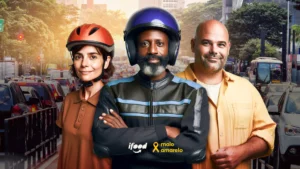Talking to the victim and calling for help are fundamental actions for the successful treatment of those who suffer a traffic accident.
Do you know what to do when you witness or are involved in a traffic accident? A simple question, but the answer is not always on the tip of your tongue. How can we help? Can the victim be moved? Who to activate? How can we provide support until the medical team arrives without running the risk of causing a new accident?
Having answers to these questions is important because first aid provided by the lay population, who are there at the time of the event, is crucial to the successful treatment of traffic accident victims.
O iFood News spoke with two experts in emergency care to put together this short guide on what should be done when a traffic accident happens: Roger Lage Alves, technical reference from the Urgency and Emergency Management of the Municipal Health Department of Belo Horizonte (MG) and Leonardo Gomes, general director of the Mobile Emergency Care Service (SAMU) in Recife (PE).
Keep Calm
Perhaps it is the most difficult step, after all witnessing or being involved in an accident is not something desirable. But if you want to help, you need to remain calm so you can provide clear and objective information to the medical team who will come to help.
Assess the risks
The second step is to take care of yourself, that is, protect yourself and then help others. “It’s about observing the scene, whether there is any additional risk of a new accident and trying to minimally signal the road”, explains Alves.
Document prepared by the State Department of Traffic (Detran) of Goiás explains that the signaling must begin before the accident site is visible so that other road users can stop or reduce speed. The exact location will vary depending on the maximum speed allowed in the location and weather conditions.
Talk to the victim and call for help
Approach the victim, ask questions. Observe if she is conscious, if she is breathing, if there is any bleeding. Try to calm and reassure her, especially so that she doesn't move until help arrives. The information collected will be important when you call 192 (SAMU telephone number) or 193 (Firefighter telephone number). “The SAMU team will ask you questions and you need to be calm to answer them”, says Gomes.
Clear and objective responses allow rescuers to provide more efficient care. “This way I will be able to better define the resource that will assist that victim”, says Alves.
What if the victim is unconscious?
It is necessary to check if the person is breathing and if they have a pulse. In some cases it may be necessary to perform a cardiac massage, a technique taught in first aid training courses for the lay population.
“The most important thing is to contact the authorities, inform them that there is a possible cardiac arrest so that the most appropriate team can be sent to provide assistance”, advises Alves. “But if it is a very serious trauma, where there is bleeding and the possibility of new accidents in the surrounding area, then there is no way to provide direct assistance”, he explains. In this case, SAMU must be called and the situation observed until the health team arrives.
Messing with the victim?
It will depend on each case and the confidence that the person providing first aid has in carrying out some maneuver or following some guidance from SAMU. “Not feeling safe, the lay person is not obliged to do anything, as they are not a health professional”, says Gomes.
Training courses teach how to properly remove a motorcycle helmet, how to immobilize or stop bleeding. Opening the visor of a helmet, rather than removing it, can help the victim breathe better and calm down. “I can adjust a victim's leg that has a fracture so that they feel less pain, I can use a damp cloth to stop bleeding, all of this is taught in training courses”, explains the director of SAMU.
I am involved in the accident, what should I do?
Staying calm, assessing the risks and calling for help are actions that are repeated if you are involved in a car accident. “If there is an injury, wait for help. If there isn’t one and you can help others by having training to do so, help”, advises Gomes. Fleeing the scene and not providing assistance — with or without victims — is not an option, as this is a violation of the Brazilian Traffic Code.
Comfort and keep company
If it is safe and possible, stay next to the victim to offer some comfort and minimize the possibility of the injured person moving their cervical and lumbar spine until first responders arrive. “You will be helping those who are in a difficult situation, which is being the victim of a traffic accident”, explains Gomes.
Time, in trauma, is worth gold
The faster the person who has suffered an accident reaches the hospital, the better the response to treatment will be. This is where the importance of assistance provided by those who witness an accident lies. Even if you do not have medical knowledge, this first approach is essential to efficiently trigger the entire chain of survival. “Whoever activates SAMU effectively will, in the end, be providing definitive treatment with greater efficiency”, recognizes Alves.
Helmet Angels
First aid is one of the pillars of education in the Helmet Angels, an iFood project in partnership with city halls in different cities across the country. So far, 550 motorcyclists have already participated in classes that cover traffic safety, accident prevention and what to do when you witness or participate in a traffic accident. The training has a theoretical part (40 hours/class) held online at iFood Takes Off. The practical part is taught by the Mobile Emergency Care Service (SAMU) and the municipal transit agency, in person, with an average duration of 4 to 5 hours.

